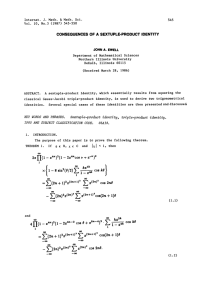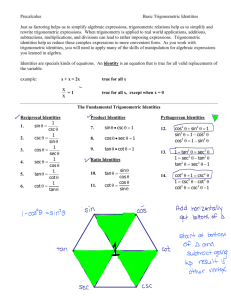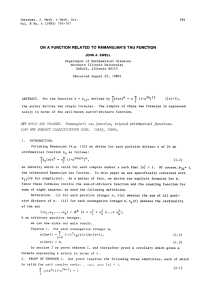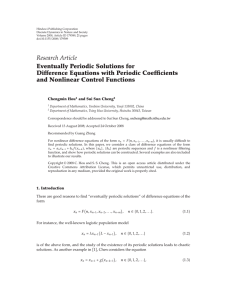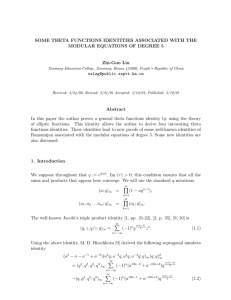Document 10442912
advertisement
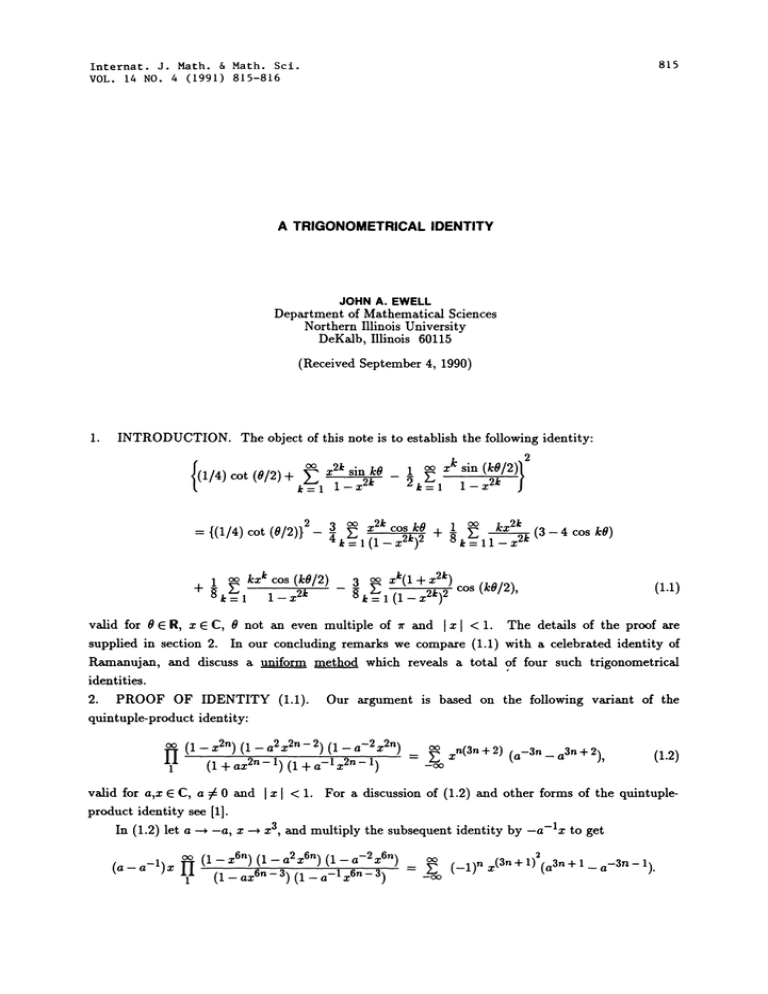
Internat. J. Math. & Math. Sci.
VOL. 14 NO. 4 (1991) 815-816
A TRIGONOMETRICAL IDENTITY
JOHN A. EWELL
Department of Mathematical Sciences
Northern Illinois University
DeKalb, Illinois 60115
(Received September 4, 1990)
1.
INTRODUCTION. The object of this note is to establish the following identity:
+
oo
k=
{(1/4) cot (0/2)}
2
x2 k
1--x2k
43-
1(1- x2k) 2
k:
gk
1-x2k
+
l--x 2k
kx2k (3- 4 cos kS)
k= ll-x2k
xk(l+ x2k) cos (k8/2),
(1 x2k) 2
3
/
k=
x 2k cos k8
k
2
zk sin
1
valid for 8ER, xEC, 8 not an even multiple of r and [x[ <1.
supplied in section 2. In our concluding remarks we compare (1.1)
Rarnanujan, and discuss a uniform method which reveals a total
identities.
2. PROOF OF IDENTITY (1.1). Our argument is based on
quintuple-product identity:
(1
x
2n) (1
-
2) (1
a 2 x2n
;::]
4-
a -2 x
a -1 x2n
2n)
1)
-oo
(1.1)
The details of the proof are
with a celebrated identity of
of four such trigonometrical
the following variant of the
xn(3n + 2) (a-3n a3n + 2),
(1.2)
valid for a,x C, a # 0 and xl < 1. For a discussion of (1.2) and other forms of the quintupleproduct identity see [1].
In (1.2) let a --. -a, x z3, and multiply the subsequent identity by -a-lx to get
(a a-1)
(1
6n) (1 a2 6n) (1 a -2 x6n)
(1--az6n-3) (1--a-lx6"-3)
x
-oo
(--1)n x(3n+
)2 (a3n+
816
J.A. EWELL
Let F(a, x) denote the left side of the foregoing identity, and for a complex variable z, regard
operator, where Dz denotes derivation with respect to z. Then,
zDz
as an
(-I) n (3n + 1) 2 x (3n+
(aDa) 2 {F(a, x)}
(a3n+
a-3n- l)
(D) {F(., )}.
We now use the technique of logarithmic differentiation to evaluate the leftmost and rightmost
members of (2.2), cancel F(a, :r) in the resulting identity, and then let z --, x I/3 to get
=1+
--6
oo
kzl: (al: + a-k)
4 E kx2k (a2k + a_2k)_
+
k= 11--z2k
(a a-1)2 k= 11-- z2/
4
kz2k +6 oo
E
E
k=ll-- m2k
oo
:r.2k
k=1(1-- m2k)2
(a2k + a_2k
+3
k=l
xk(1 + x2k) (a +a-).
(1--z2k)2
In the foregoing identity let a e i/2, subject to the stated restrictions. We simpfy the resulting
identity, d finly divide by -16 to rive at identity (1.1).
CONCLUDING REMAS. The forerunner of ] identities of type (1.1) is a celebrated one
due to uj [2, p. 139], z.,
2
(1/4)
cot
(0/2)+
{(1/4) cot (0/2)} 2 +
xk sin kO
1-xk
xk cos/cO
(I
xk)2
J
q"1/2
kxt
l_zk (1 cos/cO),
(2.4)
with the same restrictions on 0 and x. Raxnanujan himself made substantial applications of his
identity to the theory of elliptic modular functions. However, the most familiar application of the
identity is perhaps that of Hardy and Wright [3, pp. 311-314]. These authors use the identity to
establish Jacobi’s formula for the number r4(rt of representations of a natural number n by sums of
four squares. Ewell [4] shows that the method of this note permits an easy and straightforward
derivation of Ramanujan’s identity.
Moreover, the method also reveals two additional
trigonometrical identities of this type.
REFERENCES
1.
2.
3.
4.
SUBBARAO, M.V. and VIDYASAGAR, M., "On Watson’s quintuple-product identity", Proc.
Amer. Math. Soc. 26 (1970), 23-27.
RAMANUJAN, S., Collected Papers, Chelsea, New York, 1962.
HARDY, G.H. and WRIGHT, E.M., An Introduction to the Theory of Numbers, 4th ed.,
Oxford, (1960).
EWELL, J.A., "Consequences of the triple- and quintriple-product identities", Houston J.
Math. 14 (1988) 51-55.
